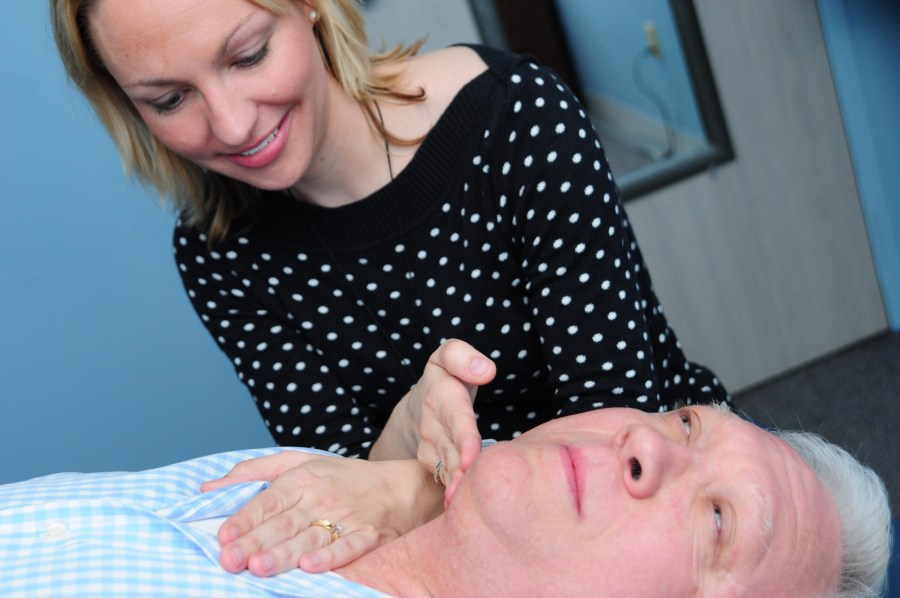
Physical Therapist Carey Tomlinson performs a vocal massage on patient Russell Witt's neck to help ease tension in his throat. (photo by Mary Donaldson)
Massage technique helps ease tension of voice disorder
Muscle tension dysphonia patients are benefiting from an outside-the-box physical therapy treatment implemented for Vanderbilt Voice Center patients including singers, teachers and call center employees.
The voice disorder is most often seen in persons who have high vocal demands at work. Patients are typically visually 'tight' and their voices are strained so they speak in a lower pitch, sometimes known as a vocal fry.
They have trouble hitting high notes, and eventually get a raspy or gruff voice that sounds like they have a cold.
Medical Director Gaelyn Garrett, M.D., and her staff of speech language pathologists had previously treated the condition with voice therapy alone for the muscles around the larynx, which include the swallowing muscles. Some patients, however, did not respond to only doing voice therapy.
“In these people who weren't responding, we started asking a lot of questions about their daily habits and we started realizing that people talk on the phone and it affects their posture; people are at a computer and it affects their posture,” Garrett said.
“And you start asking people, too, about where they focus stress and if they have any cervical spine issues, neck or shoulder issues, tension headaches. It all fell in place that if we address this whole musculoskeletal area, from the back up, it would help patients relax with their voice,” she said.
Vanderbilt Dayani Center physical therapist Carey Tomlinson worked extensively with Voice Center speech therapists to create a unique combination of specialized voice therapy and physical therapy that has resulted in significant improvement for patients previously treated unsuccessfully for other possible causes of hoarseness such as allergies and acid reflux.
“Typically with these patients you can find that something happened … they were in a car wreck, they went through a divorce, they had back surgery. Some kind of trauma is usually what starts it and then things just start spiraling down,” Tomlinson said.
One of Tomlinson's massage techniques builds on the concept of laryngeal massage, working to separate the hyoid bone, located where the chin becomes the neck, from the thyroid cartilage, which protects the vocal folds located directly behind it.
“The tension is causing them to be stuck together so we are trying to increase that space and get everything to relax,” Tomlinson said.
Garrett had previously co-authored a study with former Vanderbilt fellow and now Duke researcher Seth Cohen, M.D., that examined referral patients with hoarseness over a six-month period.
The study found that around 67 percent were either on reflux medication or had been prescribed reflux medication without improvement. Two-thirds of those patients improved with specialized therapy aimed at muscle tightness of the neck and throat.
“I was seeing patients who had been diagnosed with reflux laryngitis and, I think, a lot of them are being misdiagnosed and would benefit from doing this therapy. They don't need surgery, they don't need to be on reflux medicine,” Garrett said.
“People are getting over treated for so-called silent reflux. Truly, reflux disease is the number one diagnosis being given for people who have chronic hoarseness but you look down at the vocal folds and there is no obvious problem, no nodules. Physicians need to start looking for other potential diagnoses other than reflux.”













